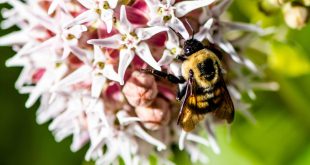Nebraska’s diverse landscapes provide habitat for a wide array of moth species, each uniquely adapted to its environment By Brianna Nugent As the sun sets over Nebraska’s expansive plains and rolling hills, a hidden world comes to life — the realm of moths, creatures of the night whose diversity and adaptations often go unnoticed. National Moth Week, celebrated globally each year, offers a unique opportunity to delve into the fascinating world of these often-overlooked insects and appreciate their importance in …
Read More »Foraging for Wild Fruits and Berries in Nebraska
I always get rather impatient this time of year. Is it because of the weather being erratic, if not so hot, humid and hazy at times? No. is it that sweet corn picking season is almost here. No. Is it that the hunting seasons are just around the bend? No. Then, why? Well, I am a gatherer, a prairie wanderer, and I am anxiously waiting to harvest elderberries during these dog days of summer. However, it’s not quite time yet. …
Read More »The Builders of the Wild – Beavers
Beavers exemplify the intricate relationship between wildlife and human communities By Monica Macoubrie, Wildlife Education Specialist Dwelling in the waterways and wetlands of Nebraska, beavers (Castor canadensis) are the architects of the Plains, shaping landscapes with their industrious dams and lodges. These remarkable rodents play a crucial role in the state’s ecosystem dynamics. From their adaptations in aquatic habitats to their significant influence on local biodiversity and water management, the presence of beavers tells the story of a species’ resilience …
Read More »Marbleseed – An Admired Plant
Marbleseed thrives in very dry, gravelly or rocky hilltop prairies where only the tough survive By Gerry Steinauer, Botanist When appearing as a guest on podcasts or radio shows, I am often asked, “What is your favorite plant?” I suppose the interviewer thinks this is a great icebreaker and that I will have a pat answer. I don’t, however, and there’s always an uncomfortable pause as I ponder. The problem is that I don’t have a favorite plant. Nebraska has …
Read More »Spirit of the Shack
Flattered … Humbled … Thrilled … These are just a few words that describe how I felt with an unexpected, major award I recently received. Called “Spirit of the Shack,” this unique conservation award is a significant one in the world of natural resources conservation. Past award winners constitute a who’s who (prominent persons list) in the conservation profession. The “Spirit of the Shack” Achievement Award is given by the Midwest Association of Fish & Wildlife Agencies (MAFWA) to the …
Read More »Surviving the Scorch – How Animals Beat the Heat
When it comes to beating the heat, animals have their own quirky playbook. By Monica Macoubrie, Wildlife Education Specialist Imagine being a furry creature in Nebraska during the peak of summer — it’s like wearing a winter coat in a sauna! While we humans crank up the AC, sip iced tea and lounge in front of fans, wildlife must get creative to beat the heat. Picture a prairie dog retreating to its underground burrow or a jackrabbit flashing its oversized …
Read More »Nebraska Nature in Color – A Rainbow of Diversity
Diversity is key to our understanding and conservation of wildlife By Alie Mayes, Community Science Specialist My parents owned a greenhouse business outside of Sedalia, Missouri, on the second half of a parking lot for a Pepto-pink antique mall. We had woodlands to the east and a stream about a quarter of a mile to the south. Months of my childhood were spent running free with my older sister and brother. We loved searching out the snakes, lizards, toads, turtles …
Read More »The Diversity of Milkweeds
Nebraska’s diverse milkweed species are keystones to the health of ecosystems and the animals that rely on them. By Monica Macoubrie, Wildlife Education Specialist Milkweed plants are indispensable keystones in ecosystems across Nebraska. These resilient and diverse species not only grace the prairies with their striking blooms, but they also serve as vital habitats and food sources for a variety of pollinators and other wildlife. From monarch butterflies that rely on milkweed as their sole host plant to bees and …
Read More »Managing Grasslands for Milkweeds and Monarchs
Practical ways landowners can increase milkweeds. Story and photos by Gerry Steinauer, Botanist The monarch butterfly is in trouble. Based on annual surveys conducted at their wintering grounds in central Mexico, the eastern North American monarch population has declined 80 percent over the past 25 years. The rapid decline has spurred the U.S. Fish and Wildlife Service to consider listing the butterfly as an endangered species. Complicating the situation, evolution has painted the monarch into a corner. They lay their …
Read More »There’s no excuse for not wearing a life jacket on the water!
It bothers me to no end that people have such cavalier excuses regarding why they don’t want to wear life jackets on the water in a boat. For instance, this year, with higher water conditions, faster currents and more debris in the water, why would you even think of not wearing a life jacket if you’re planning on boating (where there are not flood watches or warnings)? I just don’t understand it! What excuses are you going to give us? …
Read More » Nebraskaland Magazine
Nebraskaland Magazine









